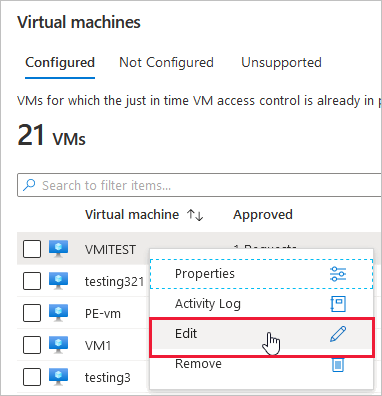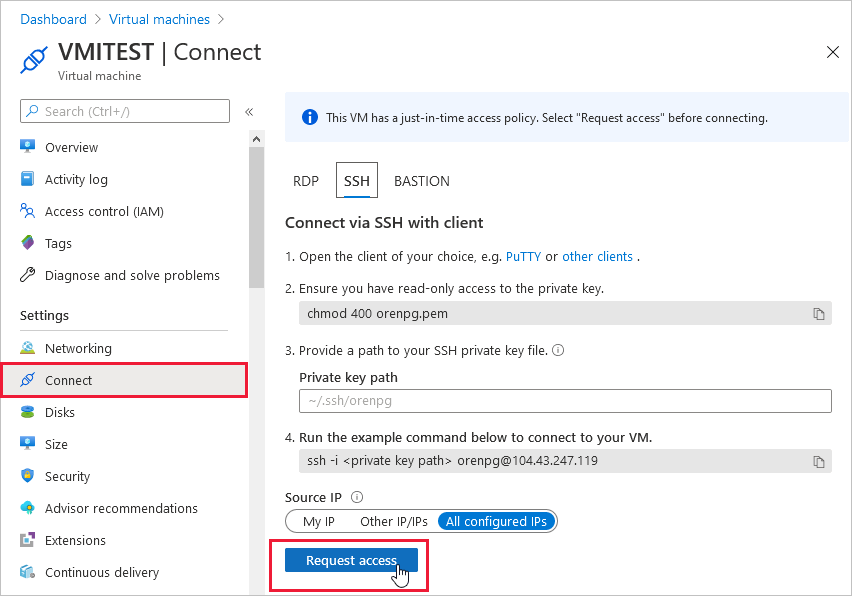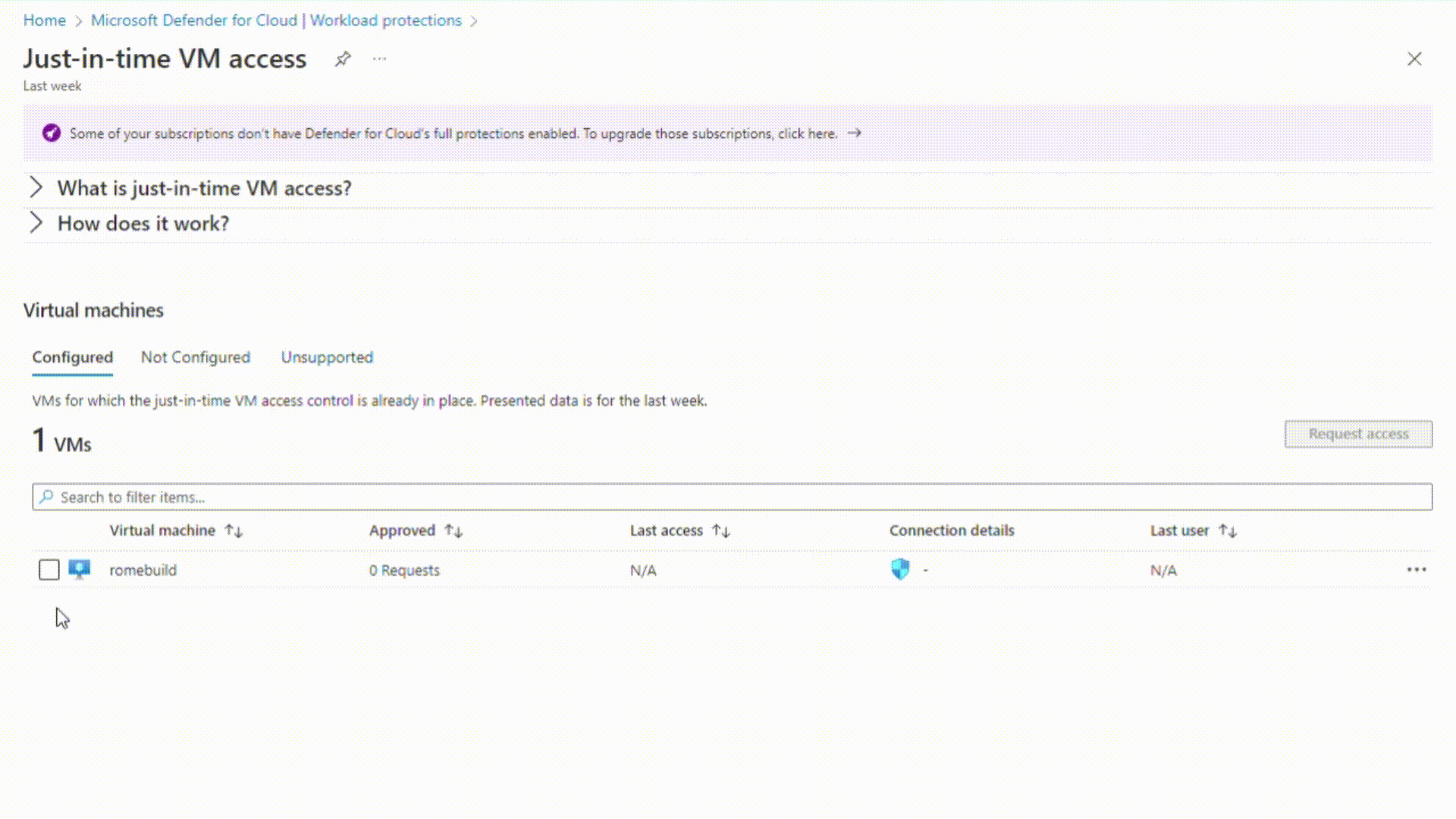Note
Access to this page requires authorization. You can try signing in or changing directories.
Access to this page requires authorization. You can try changing directories.
Defender for Servers in Microsoft Defender for Cloud provides a just-in-time machine access feature.
You can use Microsoft Defender for Cloud's just-in-time access to protect your Azure VMs from unauthorized network access. Many times firewalls contain allow rules that leave your VMs vulnerable to attack. JIT lets you allow access to your VMs only when the access is needed, on the ports needed, and for the period of time needed.
In this article, you learn how to set up and use just-in-time access, including how to:
- Enable just-in-time on VMs from the Azure portal or programmatically
- Request access to a VM that has just-in-time access enabled from the Azure portal or programmatically
- Audit just-in-time access activity to make sure your VMs are secured appropriately
Microsoft Defender for Servers Plan must be enabled on the subscription.
Supported VMs: VMs deployed through Azure Resource Manager, VMs protected by Azure Firewalls on the same VNET as the VM instances (Preview)
Unsupported VMs: VMs deployed with classic deployment models, VMs protected by Azure Firewalls controlled by Azure Firewall Manager
To JIT policy, the policy name, together with the targeted VM name, must not exceed a total of 56 characters.
You need Reader and SecurityReader permissions, or a custom role can view the JIT status and parameters.
For a custom role, assign the permissions summarized in the table. To create a least-privileged role for users that only need to request JIT access to a VM, use the Set-JitLeastPrivilegedRole script.
User action Permissions to set Configure or edit a JIT policy for a VM Assign these actions to the role: - On the scope of a subscription (or resource group when using API or PowerShell only) that is associated with the VM:
Microsoft.Security/locations/jitNetworkAccessPolicies/write - On the scope of a subscription (or resource group when using API or PowerShell only) of VM:
Microsoft.Compute/virtualMachines/write
Request JIT access to a VM Assign these actions to the user: -
Microsoft.Security/locations/jitNetworkAccessPolicies/initiate/action -
Microsoft.Security/locations/jitNetworkAccessPolicies/*/read -
Microsoft.Compute/virtualMachines/read -
Microsoft.Network/networkInterfaces/*/read -
Microsoft.Network/publicIPAddresses/read
Read JIT policies Assign these actions to the user: Microsoft.Security/locations/jitNetworkAccessPolicies/readMicrosoft.Security/locations/jitNetworkAccessPolicies/initiate/actionMicrosoft.Security/policies/readMicrosoft.Security/pricings/readMicrosoft.Compute/virtualMachines/readMicrosoft.Network/*/read
Note
To create a least-privileged role for users that only need to request JIT access to a VM, use the Set-JitLeastPrivilegedRole script.
- On the scope of a subscription (or resource group when using API or PowerShell only) that is associated with the VM:
You can use Defender for Cloud or you can programmatically enable JIT VM access with your own custom options, or you can enable JIT with default, hard-coded parameters from Azure virtual machines.
Just-in-time VM access shows your VMs grouped into:
- Configured - VMs configured to support just-in-time VM access, and shows:
- the number of approved JIT requests in the last seven days
- the last access date and time
- the connection details configured
- the last user
- Not configured - VMs without JIT enabled, but that can support JIT. We recommend that you enable JIT for these VMs.
- Unsupported - VMs that don't support JIT because:
- Missing network security group (NSG) or Azure Firewall - JIT requires an NSG to be configured or a Firewall configuration (or both)
- Classic VM - JIT supports VMs that are deployed through Azure Resource Manager.
- Other - The JIT solution is disabled in the security policy of the subscription or the resource group.
From Defender for Cloud, you can enable and configure the JIT VM access.
Open the Workload protections and, in the advanced protections, select Just-in-time VM access.
In the Not configured virtual machines tab, mark the VMs to protect with JIT and select Enable JIT on VMs.
The JIT VM access page opens listing the ports that Defender for Cloud recommends protecting:
- 22 - SSH
- 3389 - RDP
- 5985 - WinRM
- 5986 - WinRM
To customize the JIT access:
Select Add.
Select one of the ports in the list to edit it or enter other ports. For each port, you can set the:
- Protocol - The protocol that is allowed on this port when a request is approved
- Allowed source IPs - The IP ranges that are allowed on this port when a request is approved
- Maximum request time - The maximum time window during which a specific port can be opened
Select OK.
To save the port configuration, select Save.
You can modify a VM's just-in-time configuration by adding and configuring a new port to protect for that VM, or by changing any other setting related to an already protected port.
To edit the existing JIT rules for a VM:
Open the Workload protections and, in the advanced protections, select Just-in-time VM access.
In the Configured virtual machines tab, right-click on a VM and select Edit.
In the JIT VM access configuration, you can either edit the list of port or select Add a new custom port.
When you finish editing the ports, select Save.
When a VM has a JIT enabled, you have to request access to connect to it. You can request access in any of the supported ways, regardless of how you enabled JIT.
From the Just-in-time VM access page, select the Configured tab.
Select the VMs you want to access:
The icon in the Connection Details column indicates whether JIT is enabled on the network security group or firewall. If it's enabled on both, only the firewall icon appears.
The Connection Details column shows the user and ports that can access the VM.
Select Request access. The Request access window opens.
Under Request access, select the ports that you want to open for each VM, the source IP addresses that you want the port opened on, and the time window to open the ports.
Select Open ports.
Note
If a user who is requesting access is behind a proxy, you can enter the IP address range of the proxy.
You can enable JIT on a VM from the Azure virtual machines pages of the Azure portal.
Tip
If a VM already has JIT enabled, the VM configuration page shows that JIT is enabled. You can use the link to open the JIT VM access page in Defender for Cloud to view and change the settings.
From the Azure portal, search for and select Virtual machines.
Select the virtual machine you want to protect with JIT.
In the menu, select Configuration.
Under Just-in-time access, select Enable just-in-time.
By default, just-in-time access for the VM uses these settings:
- Windows machines
- RDP port: 3389
- Maximum allowed access: Three hours
- Allowed source IP addresses: Any
- Linux machines
- SSH port: 22
- Maximum allowed access: Three hours
- Allowed source IP addresses: Any
- Windows machines
To edit any of these values or add more ports to your JIT configuration, use Microsoft Defender for Cloud's just-in-time page:
From Defender for Cloud's menu, select Just-in-time VM access.
From the Configured tab, right-click on the VM to which you want to add a port, and select Edit.

Under JIT VM access configuration, you can either edit the existing settings of an already protected port or add a new custom port.
When you've finished editing the ports, select Save.
When a VM has a JIT enabled, you have to request access to connect to it. You can request access in any of the supported ways, regardless of how you enabled JIT.

To request access from Azure virtual machines:
In the Azure portal, open the virtual machines pages.
Select the VM to which you want to connect, and open the Connect page.
Azure checks to see if JIT is enabled on that VM.
If JIT isn't enabled for the VM, you're prompted to enable it.
If JIT is enabled, select Request access to pass an access request with the requesting IP, time range, and ports that were configured for that VM.
Note
After a request is approved for a VM protected by Azure Firewall, Defender for Cloud provides the user with the proper connection details (the port mapping from the DNAT table) to use to connect to the VM.
To enable just-in-time VM access from PowerShell, use the official Microsoft Defender for Cloud PowerShell cmdlet Set-AzJitNetworkAccessPolicy.
Example - Enable just-in-time VM access on a specific VM with the following rules:
- Close ports 22 and 3389
- Set a maximum time window of 3 hours for each so they can be opened per approved request
- Allow the user who is requesting access to control the source IP addresses
- Allow the user who is requesting access to establish a successful session upon an approved just-in-time access request
The following PowerShell commands create this JIT configuration:
Assign a variable that holds the just-in-time VM access rules for a VM:
$JitPolicy = (@{ id="/subscriptions/SUBSCRIPTIONID/resourceGroups/RESOURCEGROUP/providers/Microsoft.Compute/virtualMachines/VMNAME"; ports=(@{ number=22; protocol="*"; allowedSourceAddressPrefix=@("*"); maxRequestAccessDuration="PT3H"}, @{ number=3389; protocol="*"; allowedSourceAddressPrefix=@("*"); maxRequestAccessDuration="PT3H"})})Insert the VM just-in-time VM access rules into an array:
$JitPolicyArr=@($JitPolicy)Configure the just-in-time VM access rules on the selected VM:
Set-AzJitNetworkAccessPolicy -Kind "Basic" -Location "LOCATION" -Name "default" -ResourceGroupName "RESOURCEGROUP" -VirtualMachine $JitPolicyArrUse the -Name parameter to specify a VM. For example, to establish the JIT configuration for two different VMs, VM1 and VM2, use:
Set-AzJitNetworkAccessPolicy -Name VM1andSet-AzJitNetworkAccessPolicy -Name VM2.
In the following example, you can see a just-in-time VM access request to a specific VM for port 22, for a specific IP address, and for a specific amount of time:
Run the following commands in PowerShell:
Configure the VM request access properties:
$JitPolicyVm1 = (@{ id="/subscriptions/SUBSCRIPTIONID/resourceGroups/RESOURCEGROUP/providers/Microsoft.Compute/virtualMachines/VMNAME"; ports=(@{ number=22; endTimeUtc="2020-07-15T17:00:00.3658798Z"; allowedSourceAddressPrefix=@("IPV4ADDRESS")})})Insert the VM access request parameters in an array:
$JitPolicyArr=@($JitPolicyVm1)Send the request access (use the resource ID from step 1)
Start-AzJitNetworkAccessPolicy -ResourceId "/subscriptions/SUBSCRIPTIONID/resourceGroups/RESOURCEGROUP/providers/Microsoft.Security/locations/LOCATION/jitNetworkAccessPolicies/default" -VirtualMachine $JitPolicyArr
Learn more in the PowerShell cmdlet documentation.
The just-in-time VM access feature can be used via the Microsoft Defender for Cloud API. Use this API to get information about configured VMs, add new ones, request access to a VM, and more.
Learn more at JIT network access policies.
The just-in-time VM access feature can be used via the Microsoft Defender for Cloud API. Use this API to get information about configured VMs, add new ones, request access to a VM, and more.
Learn more at JIT network access policies.
You can gain insights into VM activities using log search. To view the logs:
From Just-in-time VM access, select the Configured tab.
For the VM that you want to audit, open the ellipsis menu at the end of the row.
Select Activity Log from the menu.

The activity log provides a filtered view of previous operations for that VM along with time, date, and subscription.
To download the log information, select Download as CSV.
